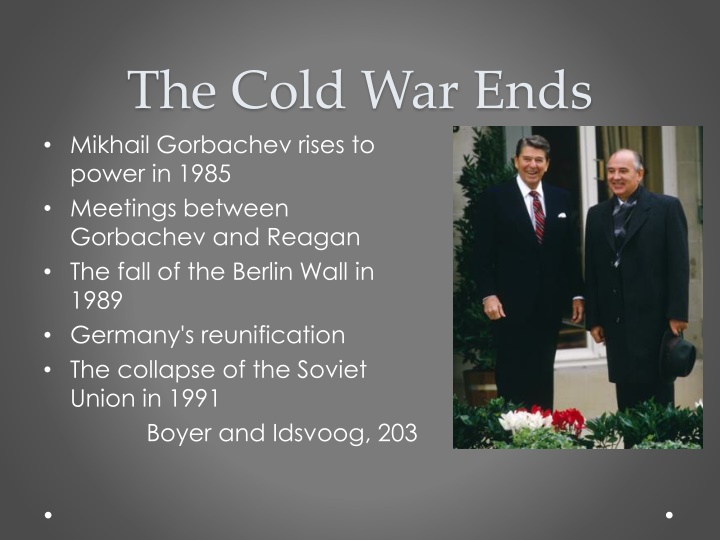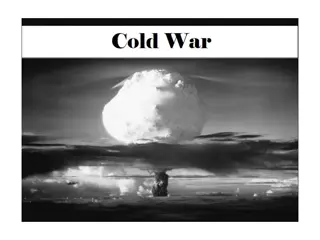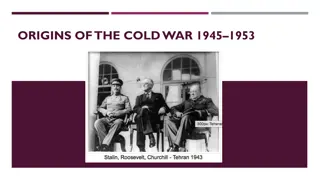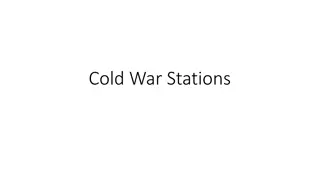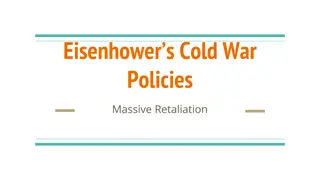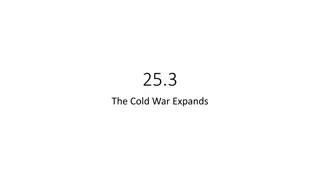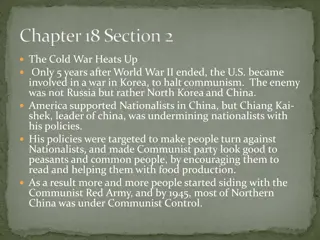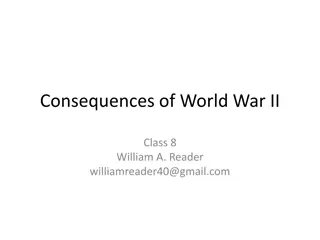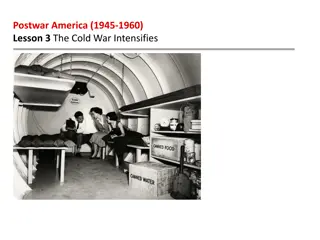The End of the Cold War: A Reflection on Nuclear Menace in the 1990s
Mikhail Gorbachev's rise to power in 1985 marked the beginning of the end of the Cold War, leading to significant events such as the fall of the Berlin Wall in 1989 and the reunification of Germany. Despite the waning nuclear arms race, nuclear themes continued to dominate mass culture in the late 1980s and 1990s, as portrayed in literature and movies like "The Hunt for Red October." The nostalgia for the Cold War era and the sources of nuclear menace in the 1990s, including chaos in the former Soviet sphere, were prevalent themes during this transitional period.
Download Presentation

Please find below an Image/Link to download the presentation.
The content on the website is provided AS IS for your information and personal use only. It may not be sold, licensed, or shared on other websites without obtaining consent from the author.If you encounter any issues during the download, it is possible that the publisher has removed the file from their server.
You are allowed to download the files provided on this website for personal or commercial use, subject to the condition that they are used lawfully. All files are the property of their respective owners.
The content on the website is provided AS IS for your information and personal use only. It may not be sold, licensed, or shared on other websites without obtaining consent from the author.
E N D
Presentation Transcript
The Cold War Ends Mikhail Gorbachev rises to power in 1985 Meetings between Gorbachev and Reagan The fall of the Berlin Wall in 1989 Germany's reunification The collapse of the Soviet Union in 1991 Boyer and Idsvoog, 203
Despite the end of the Cold War, the waning of the nuclear arms race, and the disappearance of "global thermonuclear war" from pollsters' lists of Americans' greatest worries, U.S. mass culture of the late 1980s and the 1990s was saturated by nuclear themes. Images of nuclear menace continued to pervade the movies, video games, and mass-market fiction. Boyer and Idsvoog, 199
Hunt for Red October (1990) The Hunt for Red October, the first of Clancy's popular "Jack Ryan" novels of espionage, high-level intrigue, and military derring-do, told of a rogue Soviet submarine captain, Marko Ramius, who realizes that his sub has been selected to launch a nuclear first strike against the United States. As he desperately tries to defect to the West, the KGB falsely warns Washington that Ramius himself is the threat. As both Soviet and U.S. vessels close in, and as a nuclear showdown seems inevitable, only the CIA analyst Ryan grasps the truth, and by amazing heroics prevents World War III.
Cold War Nostalgia As Harry Angstrom complains in John Updike's 1990 novel, Rabbit at Rest: "It's like nobody's in charge of the other side any more. I miss it, the cold war. It gave you a reason to get up in the morning." In the same vein, a character in the 1995 movie Crimson Tide pines for "the good of days of the Cold War, [when] the Russians could . . . be depended upon to do what was in their own best interest." (208)
Sources of nuclear menace in the 1990s Chaos in the former Soviet sphere o Tom Clancy, The Sum of All Fears (1991) o Crimson Tide (1995) Rogue States, Terrorist Groups o Under Siege (1992) terrorists named Francois and Muhammed o True Lies (1994) enemy is Crimson Jihad Nuclear Technology Run Amok o Building Bombs (1994), Plutonium Circus (1995) o The Cape (1996) Terrorists, Loners, Madmen and Amoral Scientists o The Sum of All Fears (1991)
Chaos in the Soviet Sphere Directed by Tony Scott, 1995)
Released 2002, based on Tom Clancy novel published in 1991
Saddam Hussein, supervillain Saddam Hussein's Iraq in the 1990s replaced the Soviet Union as the paradigmatic nuclear threat. Demonized by the media (often with good reason), Iraq and its supreme ruler were seen as unambiguously evil and menacing. Having long associated nuclear danger with a single, clearly defined enemy, Americans for a time elevated Saddam (sometimes in tandem with North Koreas Kim II Sung) to that role. (214)
The post-Cold War mass culture visions of nuclear menace portray a world not of government versus government, but of individuals maneuvering in an anarchic, film noir-like environment. Loners . . . take desperate measures against the irrational, dangerous, or unfair actions of their superiors. But the nuclear catastrophes threatened by such alienated individuals are typically averted by other loners who must act in the face of the inept stupidity of their superiors. (221)
Trust No One Representations of nuclear menace in the 1990s differed radically from those of the 1950s or even the early 1980s. No longer involving two superpowers posturing across an Iron Curtain, the menace now unfolded in a destabilized, decentered world where deadly hazards arise in unexpected places and assume many guises. The emblematic slogan of this new genre of nuclear horror might be the incantatory phrase used on The X-Files: "Trust no one." The prospect of a future in which nuclear weapons and nuclear know-how form a constant of the human condition is hardly reassuring. (224)
Trivialization: Video Games Duke Nukem (1991 video game)
Whatever the level of trivialization, one thing was clear as the twentieth century ended. Neither the reality of nuclear danger nor the continued presence of nuclear fear in American mass culture had disappeared with the end of the Cold War. Like the radiation-affected creatures in the science-fiction stories and movies of the 1950s, the cultural expression of that fear had simply mutated into sometimes bizarre new forms. Crysis - Nuclear Explosions (Max Settings/4xAA) [Full HD]
With some exceptions, postCold War novelists, moviemakers, and video game designers exploited nuclear danger mainly for its capacity to stir fear and build tension. Seriousness of purpose beyond the desire to elicit a passing frisson of fear was rarely evident.
